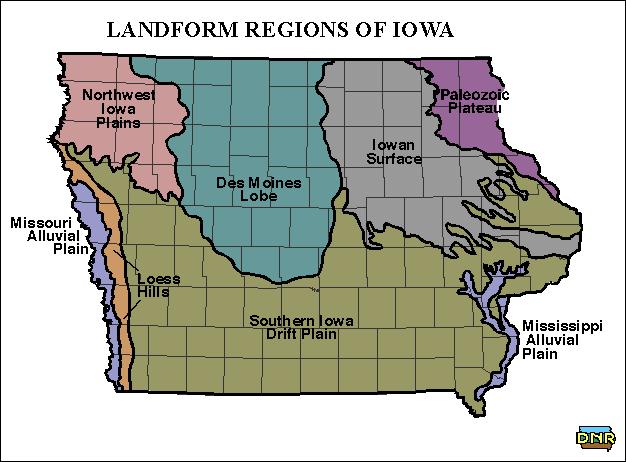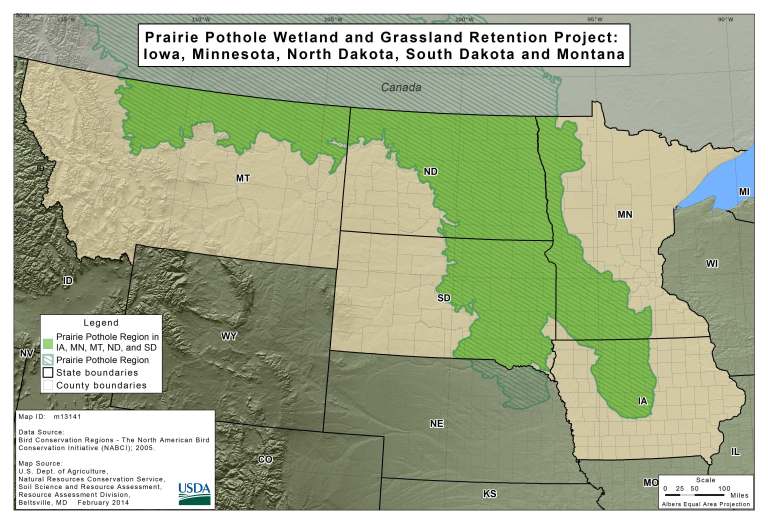In my last post, I scratched out some numbers about increased delivery of nitrate-nitrogen (N) from farmed fields to the stream network as a result of new field tile installation. In response, a farmer asked me a logical question: would enhanced crop yields (and therefore removal of nitrogen in the crop) outweigh the loss of N through the tile and out to the stream?
First, some background. Farmers have been controlling the moisture condition of their land, either through irrigation or drainage or both, since the dawn of agriculture. The ancient Greeks and Egyptians both used constructed drainage to protect cropland (1) and the Dutch began draining the Rhine River delta 800 years ago (2), in part for agriculture. Much of our land, especially in North Central Iowa on the recently-glaciated Des Moines Lobe (Figure 1), would be unfarmable without drainage because it would be under water for much of the year. At the time of European settlement, the Des Moines Lobe had 3.5 million acres of wetlands. Only about 30,000 of these wetland acres remain (3). Similar wetland losses have occurred throughout other Iowa regions.

Farmers no longer install tile to drain wetlands. Pattern-tiling fields in grids of porous pipes to lower the water table remains common, and new plastic tile is installed to replace old clay tile and upsize the existing drainage capacity. There’s not much doubt that farmers install tile, and banks readily loan money for tile installation, with the expectation that it will provide a financial return. In fact a lot of research has been done in this area and historically, tile and other forms of drainage have indeed made good economic sense for the Iowa farmer. Tiled land is also worth more on resale. Depending upon the moisture condition of the land and the overall suitability of the soils for corn and soybean production, tile can increase yields of these crops by 30% or more (1). This can produce a benefit-to-cost ratio to the farmer, depending on economic factors such as loan discount rate and income tax benefits, of 3:1 or even higher (4).
More bushels produced does mean more N leaving the field in the grain. But like everything else, we need to look at the entire ledger of processes. When evaluating N budgets, there are myriad of pathways and processes that determine how much N gets into the grain and how much is lost to the surrounding environment where it becomes water and air pollution. Tile can effect several of these pathways and processes. The table below summarizes how these effect stream nitrate, and I describe each in detail below the table.
| Process | How tile affects the process | The effects on N levels in receiving streams |
| Harvest of N in the grain | Increase | Decrease |
| Water flow through the soil profile | Increase | Increase |
| Mineralization of soil organic carbon and nitrogen | Increase | Increase |
| Denitrification in the soil profile | Decrease | Increase |
Harvest of N in the grain. Tile usually enhances conditions for corn and soy plants by drying out the soil, especially early in the growing season. This can benefit production in all sorts of ways: better germination, better root development, reduced disease pressure and overall healthier plants. Tile can also help move up the date of planting, especially for corn, to earlier in the calendar year. This gives the corn more time to develop grain, maximizing yields. Healthier plants yielding more grain use more N and, at least in theory, reduce N loss to the stream network. One big caveat here: Tile can increase the yield potential of a field, and the farmer may respond to expected higher yields with larger amounts of fertilizer. This can partially or wholly offset any N loss benefit provided by healthier plants and increased yields.
Water flow through the soil profile. There is pretty solid evidence that tile, coupled with conversion of the landscape from perennials to annual crops, has increased streamflows in Iowa and Minnesota by 30-50% (5, 6). This has happened because of the different water use patterns and growing season lengths between prairie perennials and the annuals of corn and soy. Soybeans are an especially important factor here. More water is traveling downward through the soil profile where it dissolves nitrate and transports it to the tiles and out to the streams. Less water is used by plants early and late in the growing season.
Mineralization (oxidation) of soil organic carbon and nitrogen. Much of the nitrogen in Iowa soils is tied up in organic compounds that are relatively immobile. Crops don’t use organic nitrogen; rather, they need nitrogen in inorganic forms—mainly nitrate (NO3–). Thus, organic nitrogen must be “oxidized” to nitrate before it becomes “mineral” nitrogen and “available” to plants. Nitrate is mobile and vulnerable to loss through the tile system. Tile dries out the soil and “aerates” it, e.g. exposing it to oxygen and hastening mineralization and generating loss-vulnerable nitrate. When you hear people talk about stream nitrate coming from the soil and not fertilizer, this is what they are talking about.
Denitrification. This is a process whereby bacteria in low-oxygen and high-carbon environments convert nitrate to nitrous oxide (N2O) and nitrogen (N2) gases that can escape to the atmosphere. Since tile drainage lowers the water table, it introduces air and oxygen to spaces within the soil particles that might otherwise be occupied by water, effectively increasing the amount of nitrate that can escape the deeper sections of the topsoil and enter the tile drainage network by reducing the total amount that is denitrified.
These last three factors are what lead to large nitrate losses to the stream network. In a 2016 paper I published with several of my colleagues (7), we determined the nitrogen losses from the heavily tiled landforms of the Des Moines Lobe, Northwest Iowa Plains, and Iowan Surface averaged 47, 40, and 36 pounds per acre during 2016, while N losses were far smaller in the Southern Iowa Drift Plain (19 pounds per acre) where tile drainage is much less common. This is consistent with Iowa State University research showing tile drainage as a strong driver of stream nitrate (8).
To return to my farmer’s question, neither he nor any other farmer will get an argument from me that tile drainage isn’t worth it—to the farmer. However it’s pretty clear that society at large will bear most of the burden related to the environmental consequences, i.e. algae blooms, impaired drinking water, and the Gulf of Mexico Dead Zone. These are what we call externalities, and this is a topic for another day.

- https://ridgetownc.com/research/documents/fleming_drainage.pdf.
- http://www.fao.org/fileadmin/templates/giahs/PDF/Dutch-Polder-System_2010.pdf.
- Bishop, R.A., Joens, J. and Zohrer, J., 1998. Iowa’s wetlands, present and future with a focus on prairie potholes. Journal of the Iowa Academy of Science: JIAS, 105(3), pp.89-93.
- Kanwar, R.S., Johnson, H.P., Schult, D., Fenton, T.E. and Hickman, R.D., 1983. Drainage needs and returns in North-Central Iowa. Transactions of the ASAE, 26(2), pp.457-0464.
- Schottler, S.P., Ulrich, J., Belmont, P., Moore, R., Lauer, J.W., Engstrom, D.R. and Almendinger, J.E., 2014. Twentieth century agricultural drainage creates more erosive rivers. Hydrological processes, 28(4), pp.1951-1961.
- Zhang, Y.K. and Schilling, K.E., 2006. Increasing streamflow and baseflow in Mississippi River since the 1940 s: Effect of land use change. Journal of Hydrology, 324(1-4), pp.412-422.
- Jones, C.S., Davis, C.A., Drake, C.W., Schilling, K.E., Debionne, S.H., Gilles, D.W., Demir, I. and Weber, L.J., 2018. Iowa statewide stream nitrate load calculated using in situ sensor network. JAWRA Journal of the American Water Resources Association, 54(2), pp.471-486.
- Baker, J. L., Campbell, K. L., Johnson, H. P., & Hanway, J. J. (1975). Nitrate, Phosphorus, and Sulfate in Subsurface Drainage Water 1. Journal of Environmental Quality, 4(3), 406-412